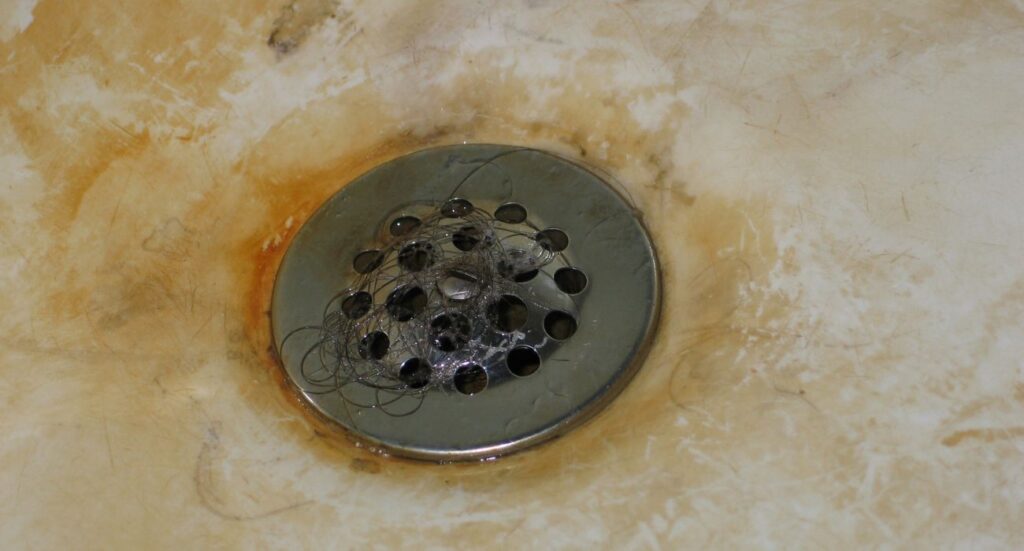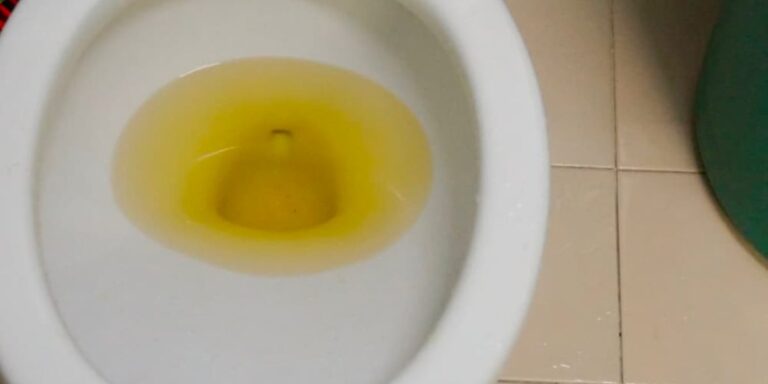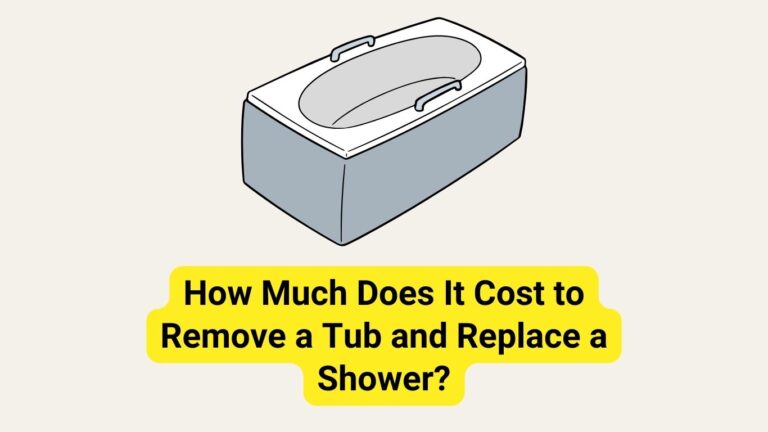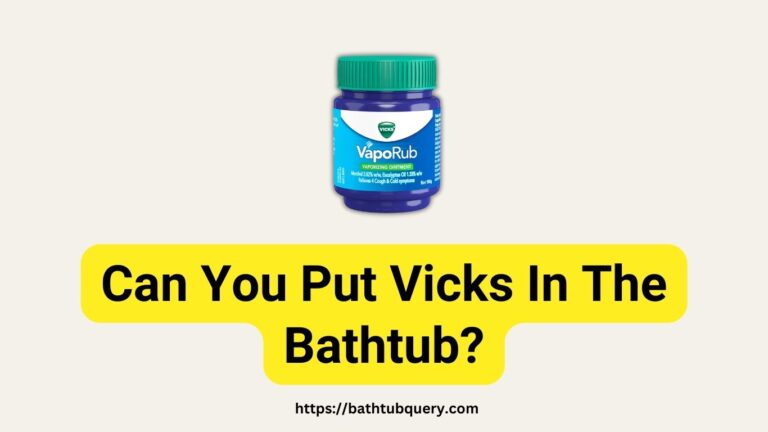How To Clean Plastic Bathtub Stains? Here’s How
The good news is you don’t necessarily need harsh chemical cleaners to get rid of bathtub stains. Depending on the type of stain, some simple household ingredients like baking soda, vinegar, lemon juice and even dish soap can lift away unsightly buildup on your plastic tub. For tougher stains, you may need a commercial plastic tub cleaner or scrubbing tool to get the job done.
Here’s a comprehensive guide on how to remove all kinds of stains from a plastic bathtub, from light cleaning for maintenance to heavy duty scrubbing for severely stained surfaces. Let’s get on with making that tub look new again!
Key Takeaway
- Mix baking soda and hydrogen peroxide into a thick paste.
- Apply paste to stains and let sit until dry.
- Use a sponge or soft brush to gently scrub paste into stains.
- Rinse the tub with warm water or wipe away excess paste.
What Causes Stains in a Plastic Bathtub?
Plastic bathtubs are prone to a variety of staining issues over time. The porous nature of plastic allows buildup to seep in and set, making stains difficult to remove. Here are some of the most common culprits for plastic bathtub stains:
- Soap Scum – This residue from bath products like soap, shampoo, and body wash can cling to plastic surfaces, leaving a dull, filmy look. The fats, oils, and minerals in these products react with hard water deposits to create soap scum.
- Hard Water Deposits – Mineral deposits from hard water leave behind calcium and limescale stains on bathtubs. These water spots etch into plastic and can be tough to scrub off.
- Mold and Mildew – Wet, humid conditions allow mold and mildew to take hold, leaving behind ugly black or green staining in bathtubs. Plastic has microscopic pores for these spores to dig into.
- Dirt and Grime – Simple dirt, dust, and oil from our bodies can build up on bathtub surfaces over time. This causes dingy looking stains on plastic tubs.
Bathtub Stains Won’t Come Out: The Core Problem And Solution
Preventing Stains in a Plastic Bathtub

Preventing stains in the first place will save you from having to scrub as much down the road. Here are some tips for keeping your plastic bathtub clean and stain-free:
- Wipe Down After Each Use – Get in the habit of using a squeegee or towel to wipe excess water from the tub after bathing. This simple step prevents soaps and minerals in the water from clinging to surfaces.
- Use a Shower Curtain – A shower curtain or door keeps water contained in the tub area, preventing splashes that lead to water spots.
- Install a Water Softener – Hard water is a common cause of bathtub stains. A whole home water softener prevents mineral deposits from building up.
- Clean Regularly – Set a reminder to deep clean your plastic tub at least once a week. Use baking soda, vinegar or ammonia-based cleaners to lift stains before they set in.
Putting in the small effort to wipe, sweep, and clean routinely will go a long way towards keeping plastic bathtubs looking fresh and stain-free. But when stains inevitably occur, don’t panic. Here are the most effective cleaners and scrubbing methods for getting rid of any type of bathtub stain.
What Causes Rust Stains in Your Bathtub? Eradicating Rust Stains
Best Cleaners for Removing Stains in Plastic Bathtubs
Not all stains are created equal. Depending on the type of buildup, you’ll need the right cleaning solution or scrubbing tool to lift the stains. Here are some of the best options for removing all kinds of dirt, grime, soap scum, and hard water stains from plastic bathtub surfaces:
| Type of Stain | Best Cleaning Solutions |
|---|---|
| Soap Scum | Baking Soda, Vinegar, and ammonia cleaners |
| Hard Water Deposits | Vinegar, Liquid Cleaners with Bleach |
| Mold and Mildew | Bleach Cleaners, Commercial Plastic Tub Cleaners |
| Dirt and Grime | Dish Soap, Baking Soda, Commercial Cleaners |
Baking Soda and Vinegar
This classic DIY combination works wonders to break down many types of stains without harsh chemicals. Baking soda is a natural abrasive that lifts dirt, while vinegar dissolves soap scum, hard water deposits, and grime.
To use it:
- Sprinkle baking soda liberally over the stained areas of the tub.
- Spray vinegar directly onto the baking soda. Let fizz for 2-3 minutes.
- Scrub with a stiff brush or sponge.
- Rinse thoroughly with hot water.
Vinegar’s acidity fights stains, while baking soda scrubs them away. Together, they dissolve residue and lift buildup without damaging the plastic surface.
Liquid Cleaners With Bleach or Ammonia
For tougher stains that need more heavy duty cleaning power, use a liquid cleaner containing either bleach or ammonia. Check the product label to ensure it’s formulated for use on plastic.
These abrasive cleaners penetrate and disinfect stained areas, removing mold, mildew, soap scum, and hard water stains. The chemicals can be harsh, so open windows and wear gloves when using them.
Apply the cleaner directly to stained areas and let it sit 5-10 minutes before scrubbing and rinsing. Reapply if needed for stubborn buildup. See these 13 best homemade cleaners.
Commercial Plastic Tub & Tile Cleaners
Look for cleaners specifically made for plastic bathtubs and tiles. These formulas contain surfactants to break down stains along with mild abrasives to lift buildup without scratching.
Spray or wipe the cleaner over stained areas. Allow it to sit before scrubbing with a sponge or old toothbrush. Rinse thoroughly after cleaning.
These cleaners simplify the stain removal process, combining stain-fighting ingredients in one easy product.
How to Clean Plastic Bathtub Stains? Step-By-Step Guide for Removing Tough Bathtub Stains
Once you’ve identified the type of stain, follow this complete step-by-step process for attacking even severe buildup and discoloration in a plastic bathtub:
Prep the Tub
Before getting started, prep the tub by:
- Removing any bathmats, shower caddies or accessories that may get in the way
- Draining any standing water
- Wiping down excess moisture with an old towel
This prevents cleaner runoff and allows you to focus just on stained areas.
Apply Cleaner and Let Sit
Next, apply your chosen cleaner, whether it’s baking soda, bleach, ammonia, or a commercial plastic tub cleaner. Use a generous amount, really working it into the stained areas.
Let the cleaning agent sit for 5-10 minutes (or according to product directions). This dwell time allows the active ingredients to penetrate and loosen caked-on grime.
Scrub and Wipe Away
Now comes the elbow grease! Use a scrub brush, sponge, or old toothbrush to aggressively scrub stained areas, working the cleaner over the surface.
Scrub until you see the stains lifting away, then rinse thoroughly with hot water to wash off all the grime and cleaning residue.
Go over the surface with a clean microfiber cloth, wiping away excess moisture to keep water spots from developing.
Repeat as Needed for Stubborn Stains
You may need to reapply cleaner and repeat the scrubbing process for very stubborn bathtub stains. Give the plastic adequate time to completely dry before reapplying cleaner.
Some neglected tubs may take multiple cleaning sessions to get them back to a like-new condition. Just keep at it, reapplying cleaner and scrubbing until the stains have lifted.
Maintaining a Pristine Plastic Bathtub
Once you’ve conquered those impossible tub stains, a little regular maintenance will keep your plastic bathtub looking freshly cleaned. Here are some tips for keeping it stain-free long-term:
- Wipe Down After Every Use – Never skip your post-bath wipe down. This simple habit prevents stains in the first place.
- Clean 1-2 Times Monthly – Schedule out a monthly deep clean to tackle grime before it becomes stubborn stains.
- Re-Caulk if Needed – If mildew is present along caulk lines, remove and re-caulk to prevent recurring stains.
- Install a Water Softener – This is the #1 solution for preventing hard water stains from reforming.
- Address Ventilation Issues – Improve ventilation to prevent moisture that breeds ugly mold and mildew stains.
With a little diligent maintenance, you can avoid frequent heavy duty stain removal in your plastic bathtub. But when stains inevitably occur, refer back to these steps to get your tub sparkling again!
Conclusion
That feeling when you finally conquer those impossible looking stains in your plastic bathtub – amazing, right? While stains are simply a fact of life with plastic tubs, arming yourself with the right cleaning solutions and techniques makes removing them much more manageable.
Give baking soda, vinegar, ammonia and commercial plastic cleaners a try. Pack patience and some serious elbow grease for scrubbing. Maintain that tub diligently after cleaning. And know when to bring in pro reinforcements.
Follow these tips and you’ll be on your way to a stain-free tub that makes your entire bathroom look bright, clean and refreshed. Who knew a sparkling, clean bathtub could bring such satisfaction? Happy scrubbing!
Frequently Asked Questions
How do you get stains out of a plastic bathtub?
Mix baking soda and hydrogen peroxide into a paste and apply it to the stains. Let it sit before scrubbing gently with a sponge or brush. The paste will help lift stains without scratching the plastic. Rinse well after.
What is the best cleaner for plastic baths?
For plastic baths, make a paste of baking soda and hydrogen peroxide. Apply the paste and let it sit before gently scrubbing. The mixture cleans without scratching. Rinse thoroughly after.
How do you get stains out of a plastic tub surround?
Make a paste of baking soda and hydrogen peroxide and apply it to the plastic surround stains. Let it sit to work before scrubbing gently with a soft sponge or brush. This lifts stains without harming the plastic. Rinse off completely after.
Can you remove bathtub stains?
Yes, you can remove bathtub stains by making a paste of baking soda and hydrogen peroxide. Apply the paste to the stains and let it sit before scrubbing gently. The paste will lift stains without damaging the tub surface. Rinse thoroughly afterwards.
Related articles:
- Can You Clean Your Bathtub with Dawn?
- How To Clean A Disgusting Bathtub?
- Can I Clean My Bathtub with Baking Soda?

William J. Bullock is a licensed plumber with over 15 years of experience installing and repairing bathtubs. He runs his own plumbing company in Greenville and serves residential and commercial clients. William is dedicated to providing honest, transparent advice to help homeowners make informed decisions about their bathroom renovations.
He has established expertise in selecting bathtubs, planning custom installations, diagnosing issues, and completing repairs. William aims to share practical tips and reliable recommendations based on extensive hands-on work. When he isn’t on a job site, William enjoys spending time with his family and volunteering at local community events. He takes pride in delivering quality service and enjoys helping people upgrade their homes.







